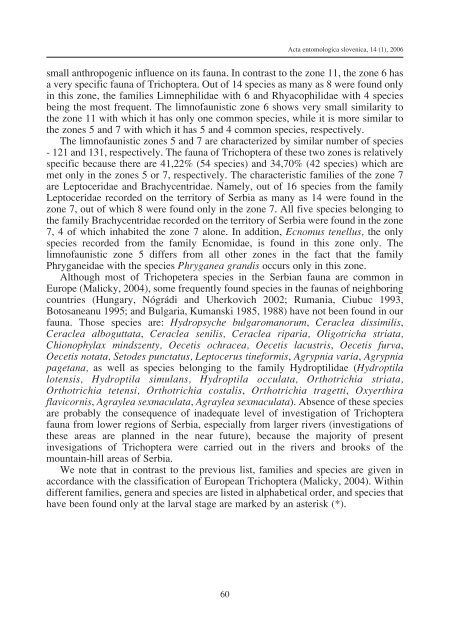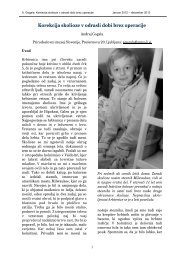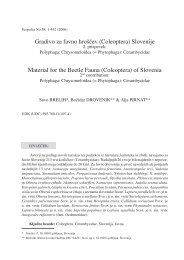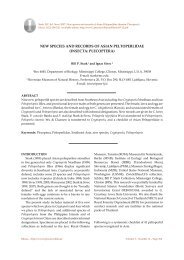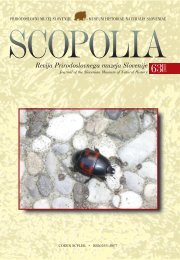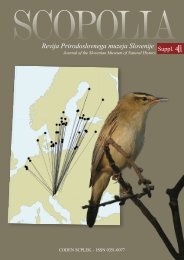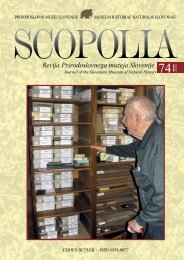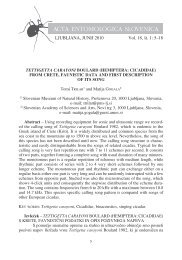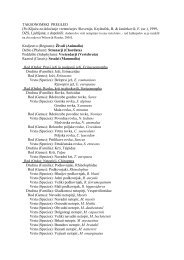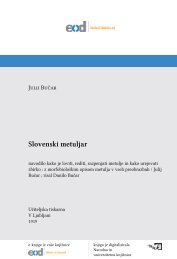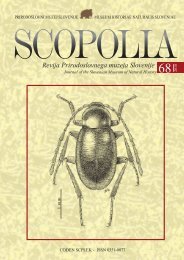Acta entomologica slovenica, 14 (1), 2006small anthropogenic influence on its fauna. In contrast to the zone 11, the zone 6 hasa very specific fauna of Trichoptera. Out of 14 species as many as 8 were found onlyin this zone, the families Limnephilidae with 6 and Rhyacophilidae with 4 speciesbeing the most frequent. The limnofaunistic zone 6 shows very small similarity tothe zone 11 with which it has only one common species, while it is more similar tothe zones 5 and 7 with which it has 5 and 4 common species, respectively.The limnofaunistic zones 5 and 7 are characterized by similar number of species- 121 and 131, respectively. The fauna of Trichoptera of these two zones is relativelyspecific because there are 41,22% (54 species) and 34,70% (42 species) which aremet only in the zones 5 or 7, respectively. The characteristic families of the zone 7are Leptoceridae and Brachycentridae. Namely, out of 16 species from the familyLeptoceridae recorded on the territory of Serbia as many as 14 were found in thezone 7, out of which 8 were found only in the zone 7. All five species belonging tothe family Brachycentridae recorded on the territory of Serbia were found in the zone7, 4 of which inhabited the zone 7 alone. In addition, Ecnomus tenellus, the onlyspecies recorded from the family Ecnomidae, is found in this zone only. Thelimnofaunistic zone 5 differs from all other zones in the fact that the familyPhryganeidae with the species Phryganea grandis occurs only in this zone.Although most of Trichopetera species in the Serbian fauna are common inEurope (Malicky, 2004), some frequently found species in the faunas of neighboringcountries (Hungary, Nógrádi and Uherkovich 2002; Rumania, Ciubuc 1993,Botosaneanu 1995; and Bulgaria, Kumanski 1985, 1988) have not been found in ourfauna. Those species are: Hydropsyche bulgaromanorum, Ceraclea dissimilis,Ceraclea alboguttata, Ceraclea senilis, Ceraclea riparia, Oligotricha striata,Chionophylax mindszenty, Oecetis ochracea, Oecetis lacustris, Oecetis furva,Oecetis notata, Setodes punctatus, Leptocerus tineformis, Agrypnia varia, Agrypniapagetana, as well as species belonging to the family Hydroptilidae (Hydroptilalotensis, Hydroptila simulans, Hydroptila occulata, Orthotrichia striata,Orthotrichia tetensi, Orthotrichia costalis, Orthotrichia tragetti, Oxyerthiraflavicornis, Agraylea sexmaculata, Agraylea sexmaculata). Absence of these speciesare probably the consequence of inadequate level of investigation of Trichopterafauna from lower regions of Serbia, especially from larger rivers (investigations ofthese areas are planned in the near future), because the majority of presentinvesigations of Trichoptera were carried out in the rivers and brooks of themountain-hill areas of Serbia.We note that in contrast to the previous list, families and species are given inaccordance with the classification of European Trichoptera (Malicky, 2004). Withindifferent families, genera and species are listed in alphabetical order, and species thathave been found only at the larval stage are marked by an asterisk (*).60
Ivana Æiviå, Zoran Markoviå, Miloje Brajkoviå: Contribution to the faunistical list of Trichoptera (Insecta) of SerbiaReferencesBotosaneanu, L. and Malicky, H., 1978: Trichoptera. In: Illies, J. (eds) LimnofaunaEuropea, Gustav Fischer Verlag, Stuttgart, 333-359.Botosaneanu, L., 1995: Additional documents to the knowledge of the Trichopteraof Romania, with data on European taxa from outside of this country (Insecta:Trichoptera). - Faunistische Abhandlunglen (Dresden) 20 (6): 57-88.Ciubuc, C., 1993: Check list of Romanian Trichoptera (Insecta). Trav. Mus. His.nat.“Grigore Antipa”, Vol. XXXIII, 11-147.Illies, J., 1978: Limnofauna Europea, Gustav Fischer Verlag, Stuttgart, 532pp.Kumanski, K. P., 1985: Trichoptera, Annulipalpia. Fauna na Balgaria 15: 1-244.Kumanski, K. P., 1988: Trichoptera, Integripalpia. Fauna na Balgaria 19: 1-354.Lepneva, S.G., 1964: Ryœeinki-Trichoptera. Tom II. Vyp.1. Fauna SSSR. “Nauka”,Moskva-Leningrad, 558.Lepneva, S.G. 1966: Ryœeinki Trichoptera. Tom II. Vyp.6. Fauna SSSR. “Nauka”,Moskva-Leningrad, 560.Malicky, H. 2004: Atlas of European Trichoptera, Second Edition. Springer,Dordrecht, 359pp.Marinkoviå-Gospodnetiå, M., 1975: Fauna Trichoptera SR Srbije. Zbornik radovao entomofauni SR Srbije, 1, 219–236.Marinkoviå-Gospodnetiå, M., 1978: Some characteristris of the Yugoslavia faunaof Trichoptera. Proc. of the 2 nd Int. Symp. on Trichoptera. Junk, the Hugue, 35-40.Marinkoviå-Gospodnetiå, M. 1980: Fauna Trichoptera SR Srbije. Zbornik radovao fauni SR Srbije, 1, 71–84.Martinoviå-Vitanoviå, V., Kalafatiå, V., Jakovœev, D., Paunoviå, M, iMartinoviå, M. J., 1998: Reka Veternica-sastav i stuktura biocenoza,saprobioloøki status i kvalitet vode. Ecologica, 5 (3), 22–28.Nógrádi, S. and Uherkovich, Á., 2002: Magyarország tegzesei (Trichoptera). Thecaddisflies (Trichoptera) of Hungary. Dunántúli DolgozatokTermészettudományi Sorozat (Pécs) 11: 1-386.Paunoviå, M., 2001: Prostorna i sezonska dinamika makrozoobentosa reke Vlasine.Magistarski rad, Bioloøki fakultet Univerziteta u Beogradu, 200pp.Radovanoviå, M., 1931: Rezultati ispitivanja balkanskih Trihoptera. GlasnikJugoslovenskog entomoloøkog druøtva, 1-2, 159–192.Radovanoviå, M., 1935: Trihoptera Jugoslavije. Glasnik Zemaljskog <strong>muzej</strong>a u Bosnii Hercegovini u Sarajevu, XLVII, 73–84.Radovanoviå, M., 1953: Prilog poznavanju Trichoptera Balkanskog poluostrva,prvenstveno u peåinama i planinskim jezerima. Glas SANCCX, 7, 11–38.Sedlak, E. 1980: Red Chrostici-Trichoptera, pp. 163-219. In Rozkoøny, R (ed.) Kliœlarev vodniho hmyzu. Œeskoslovenska Akademie Ved, Praha.Simiå, V. 1993: Saprobioloøka valorizacija Svrljiøkog i Trgoviøkog Timoka naosnovu sastava makrozoobentosa. Magistarski rad, Bioloøki fakultetUniverziteta u Beogradu, 263pp.61
- Page 1:
Vsebina / ContentsL. SENŒIŒ: Inte
- Page 4:
ISSN 1318-1998CODEN: AESLFMUDC (UDK
- Page 7 and 8:
ACTA ENTOMOLOGICA SLOVENICALJUBLJAN
- Page 9 and 10:
Leon Senœiœ: Intensity of wing pi
- Page 11 and 12: Leon Senœiœ: Intensity of wing pi
- Page 13 and 14: ACTA ENTOMOLOGICA SLOVENICALJUBLJAN
- Page 17 and 18: Gabrijel Seljak: An overview of the
- Page 19 and 20: Gabrijel Seljak: An overview of the
- Page 21 and 22: Gabrijel Seljak: An overview of the
- Page 23 and 24: Gabrijel Seljak: An overview of the
- Page 25 and 26: Gabrijel Seljak: An overview of the
- Page 27 and 28: Gabrijel Seljak: An overview of the
- Page 29 and 30: Gabrijel Seljak: An overview of the
- Page 31 and 32: Gabrijel Seljak: An overview of the
- Page 33 and 34: Gabrijel Seljak: An overview of the
- Page 35 and 36: Gabrijel Seljak: An overview of the
- Page 37 and 38: ACTA ENTOMOLOGICA SLOVENICALJUBLJAN
- Page 39 and 40: Bojan Kofler: Anophthalmus miroslav
- Page 41 and 42: Bojan Kofler: Anophthalmus miroslav
- Page 43 and 44: Bojan Kofler: Anophthalmus miroslav
- Page 45 and 46: ACTA ENTOMOLOGICA SLOVENICALJUBLJAN
- Page 47 and 48: Tone Lesar, Matjaæ Jeæ: Prispevek
- Page 49 and 50: Tone Lesar, Matjaæ Jeæ: Prispevek
- Page 51 and 52: Tone Lesar, Matjaæ Jeæ: Prispevek
- Page 53 and 54: Tone Lesar, Matjaæ Jeæ: Prispevek
- Page 55 and 56: Tone Lesar, Matjaæ Jeæ: Prispevek
- Page 57 and 58: ACTA ENTOMOLOGICA SLOVENICALJUBLJAN
- Page 59 and 60: Ivana Æiviå, Zoran Markoviå, Mil
- Page 61: Ivana Æiviå, Zoran Markoviå, Mil
- Page 65 and 66: Ivana Æiviå, Zoran Markoviå, Mil
- Page 67 and 68: Ivana Æiviå, Zoran Markoviå, Mil
- Page 69 and 70: Ivana Æiviå, Zoran Markoviå, Mil
- Page 71 and 72: ACTA ENTOMOLOGICA SLOVENICALJUBLJAN
- Page 73 and 74: Ljiljana Protiå: Nabidae (Heteropt
- Page 75 and 76: Ljiljana Protiå: Nabidae (Heteropt
- Page 77 and 78: Ljiljana Protiå: Nabidae (Heteropt
- Page 79 and 80: Ljiljana Protiå: Nabidae (Heteropt
- Page 81 and 82: Ljiljana Protiå: Nabidae (Heteropt
- Page 83 and 84: ACTA ENTOMOLOGICA SLOVENICALJUBLJAN
- Page 85 and 86: M Aydogdu, A. Beyarslan: First reco
- Page 87 and 88: M Aydogdu, A. Beyarslan: First reco
- Page 89 and 90: M Aydogdu, A. Beyarslan: First reco
- Page 91 and 92: ACTA ENTOMOLOGICA SLOVENICALJUBLJAN
- Page 93 and 94: Emine Demir: Preliminary report on
- Page 95 and 96: Emine Demir: Preliminary report on
- Page 97 and 98: Emine Demir: Preliminary report on
- Page 99 and 100: Emine Demir: Preliminary report on
- Page 101 and 102: Emine Demir: Preliminary report on
- Page 103 and 104: Emine Demir: Preliminary report on
- Page 105 and 106: Favnistiœni zapiski / Faunistical
- Page 107 and 108: Abdullah Hasbenli, Fatma Bayrakdar,
- Page 109 and 110: Vabilo na Prvi slovenski entomoloø


